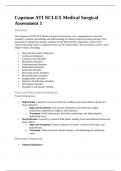Capstone ATI NCLEX Medical Surgical
Assessment 1
Overview
The Capstone ATI NCLEX Medical Surgical Assessment 1 is a comprehensive exam that
evaluates a student's knowledge and understanding of medical-surgical nursing concepts. This
assessment is designed to prepare students for the NCLEX-RN examination, which is the
national licensing exam for registered nurses in the United States. The assessment covers a wide
range of topics, including:
Fluid and electrolyte imbalances
Acid-base imbalances
Cardiovascular disorders
Respiratory disorders
Gastrointestinal disorders
Neurological disorders
Endocrine disorders
Renal and urinary disorders
Musculoskeletal disorders
Integumentary disorders
Immune and infectious disorders
Oncological disorders
Emergency and disaster nursing
Fluid and Electrolyte Imbalances
Fluid Imbalances
Dehydration: Caused by excessive fluid loss, leading to decreased blood volume and
tissue perfusion.
o Signs and Symptoms: Dry mucous membranes, decreased skin turgor,
tachycardia, hypotension, oliguria, and confusion.
o Treatment: Fluid replacement, electrolyte monitoring, and addressing the
underlying cause.
Overhydration: Caused by excessive fluid intake, leading to increased blood volume and
tissue edema.
o Signs and Symptoms: Edema, shortness of breath, crackles in the lungs, and
hypertension.
o Treatment: Fluid restriction, diuretic therapy, and addressing the underlying
cause.
Electrolyte Imbalances
Sodium Imbalances:
, o Hyponatremia: Caused by decreased sodium levels, leading to fluid shifts and
cellular edema.
Signs and Symptoms: Nausea, vomiting, headache, confusion, and
seizures.
Treatment: Fluid restriction, sodium replacement, and addressing the
underlying cause.
o Hypernatremia: Caused by increased sodium levels, leading to fluid shifts and
cellular dehydration.
Signs and Symptoms: Thirst, dry mucous membranes, confusion, and
seizures.
Treatment: Fluid replacement, sodium restriction, and addressing the
underlying cause.
Potassium Imbalances:
o Hypokalemia: Caused by decreased potassium levels, leading to muscle
weakness and cardiac arrhythmias.
Signs and Symptoms: Muscle cramps, weakness, and cardiac
arrhythmias.
Treatment: Potassium replacement and addressing the underlying cause.
o Hyperkalemia: Caused by increased potassium levels, leading to cardiac
conduction disturbances and muscle weakness.
Signs and Symptoms: Muscle weakness, nausea, and cardiac
arrhythmias.
Treatment: Calcium administration, insulin and glucose therapy, and
addressing the underlying cause.
Acid-Base Imbalances
Metabolic Acidosis
Causes: Diabetic ketoacidosis, lactic acidosis, renal failure, and ingestion of certain
substances.
Signs and Symptoms: Rapid breathing, fruity breath odor, nausea, and confusion.
Treatment: Addressing the underlying cause, fluid and electrolyte replacement, and
administration of bicarbonate if necessary.
Metabolic Alkalosis
Causes: Vomiting, diuretic therapy, and excessive antacid use.
Signs and Symptoms: Muscle cramps, tetany, and cardiac arrhythmias.
Treatment: Addressing the underlying cause, fluid and electrolyte replacement, and
administration of chloride if necessary.
Respiratory Acidosis
Causes: Chronic obstructive pulmonary disease (COPD), neuromuscular disorders, and
respiratory depression.
Signs and Symptoms: Headache, confusion, and drowsiness.




